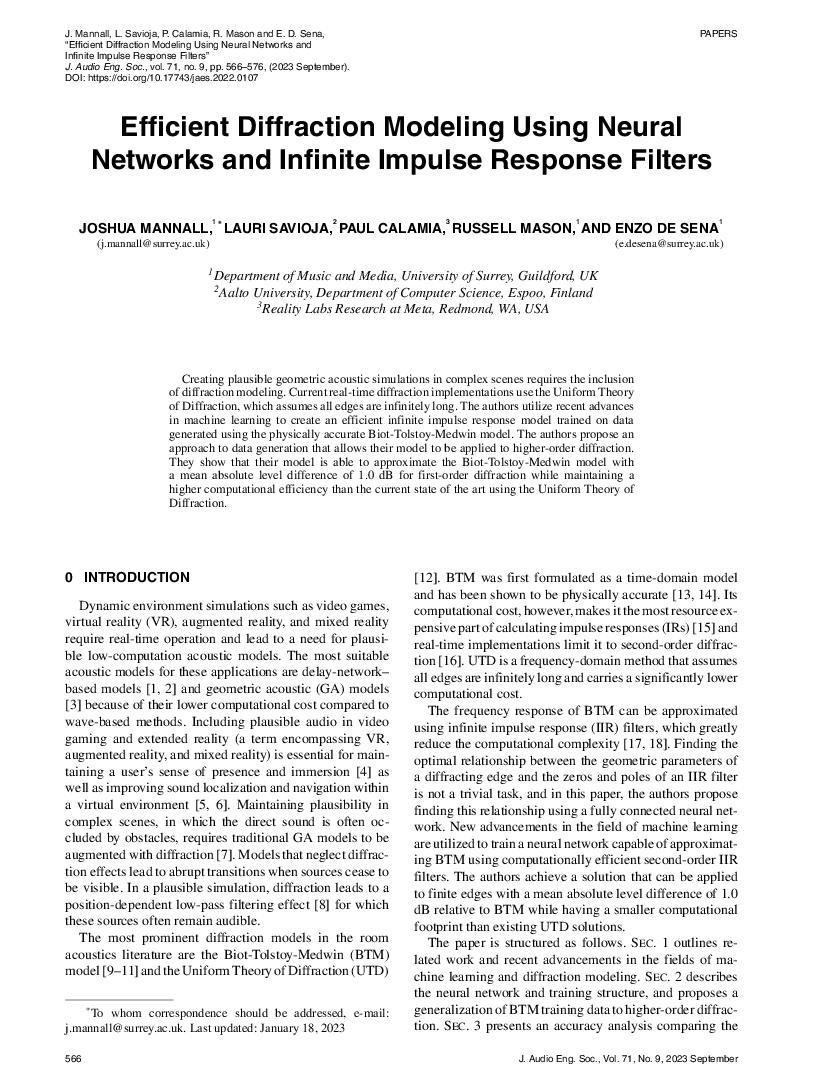Home / Publications / E-library page
You are currently logged in as an
Institutional Subscriber.
If you would like to logout,
please click on the button below.
Home / Publications / E-library page
Only AES members and Institutional Journal Subscribers can download
Creating plausible geometric acoustic simulations in complex scenes requires the inclusion of diffraction modeling. Current real-time diffraction implementations use the Uniform Theory of Diffraction, which assumes all edges are infinitely long. The authors utilize recent advances in machine learning to create an efficient infinite impulse response model trained on data generated using the physically accurate Biot-Tolstoy-Medwin model. The authors propose an approach to data generation that allows their model to be applied to higher-order diffraction. They show that their model is able to approximate the Biot-Tolstoy-Medwin model with a mean absolute level difference of 1.0 dB for first-order diffraction while maintaining a higher computational efficiency than the current state of the art using the Uniform Theory of Diffraction.
Author (s): Mannall, Joshua; Savioja, Lauri; Calamia, Paul; Mason, Russell; De Sena, Enzo
Affiliation:
Department of Music and Media, University of Surrey, Guildford, UK; Aalto University, Department of Computer Science, Espoo, Finland; Reality Labs Research at Meta, Redmond, WA, USA; Department of Music and Media, University of Surrey, Guildford, UK; Department of Music and Media, University of Surrey, Guildford, UK
(See document for exact affiliation information.)
Publication Date:
2023-09-06
Import into BibTeX
Permalink: https://aes2.org/publications/elibrary-page/?id=22232
(1346KB)
Click to purchase paper as a non-member or login as an AES member. If your company or school subscribes to the E-Library then switch to the institutional version. If you are not an AES member Join the AES. If you need to check your member status, login to the Member Portal.

Mannall, Joshua; Savioja, Lauri; Calamia, Paul; Mason, Russell; De Sena, Enzo; 2023; Efficient Diffraction Modeling Using Neural Networks and Infinite Impulse Response Filters [PDF]; Department of Music and Media, University of Surrey, Guildford, UK; Aalto University, Department of Computer Science, Espoo, Finland; Reality Labs Research at Meta, Redmond, WA, USA; Department of Music and Media, University of Surrey, Guildford, UK; Department of Music and Media, University of Surrey, Guildford, UK; Paper ; Available from: https://aes2.org/publications/elibrary-page/?id=22232
Mannall, Joshua; Savioja, Lauri; Calamia, Paul; Mason, Russell; De Sena, Enzo; Efficient Diffraction Modeling Using Neural Networks and Infinite Impulse Response Filters [PDF]; Department of Music and Media, University of Surrey, Guildford, UK; Aalto University, Department of Computer Science, Espoo, Finland; Reality Labs Research at Meta, Redmond, WA, USA; Department of Music and Media, University of Surrey, Guildford, UK; Department of Music and Media, University of Surrey, Guildford, UK; Paper ; 2023 Available: https://aes2.org/publications/elibrary-page/?id=22232
@article{mannall2023efficient,
author={mannall joshua and savioja lauri and calamia paul and mason russell and de sena enzo},
journal={journal of the audio engineering society},
title={efficient diffraction modeling using neural networks and infinite impulse response filters},
year={2023},
volume={71},
issue={9},
pages={566-576},
month={september},}
TY – paper
TI – Efficient Diffraction Modeling Using Neural Networks and Infinite Impulse Response Filters
SP – 566 EP – 576
AU – Mannall, Joshua
AU – Savioja, Lauri
AU – Calamia, Paul
AU – Mason, Russell
AU – De Sena, Enzo
PY – 2023
JO – Journal of the Audio Engineering Society
VO – 71
IS – 9
Y1 – September 2023